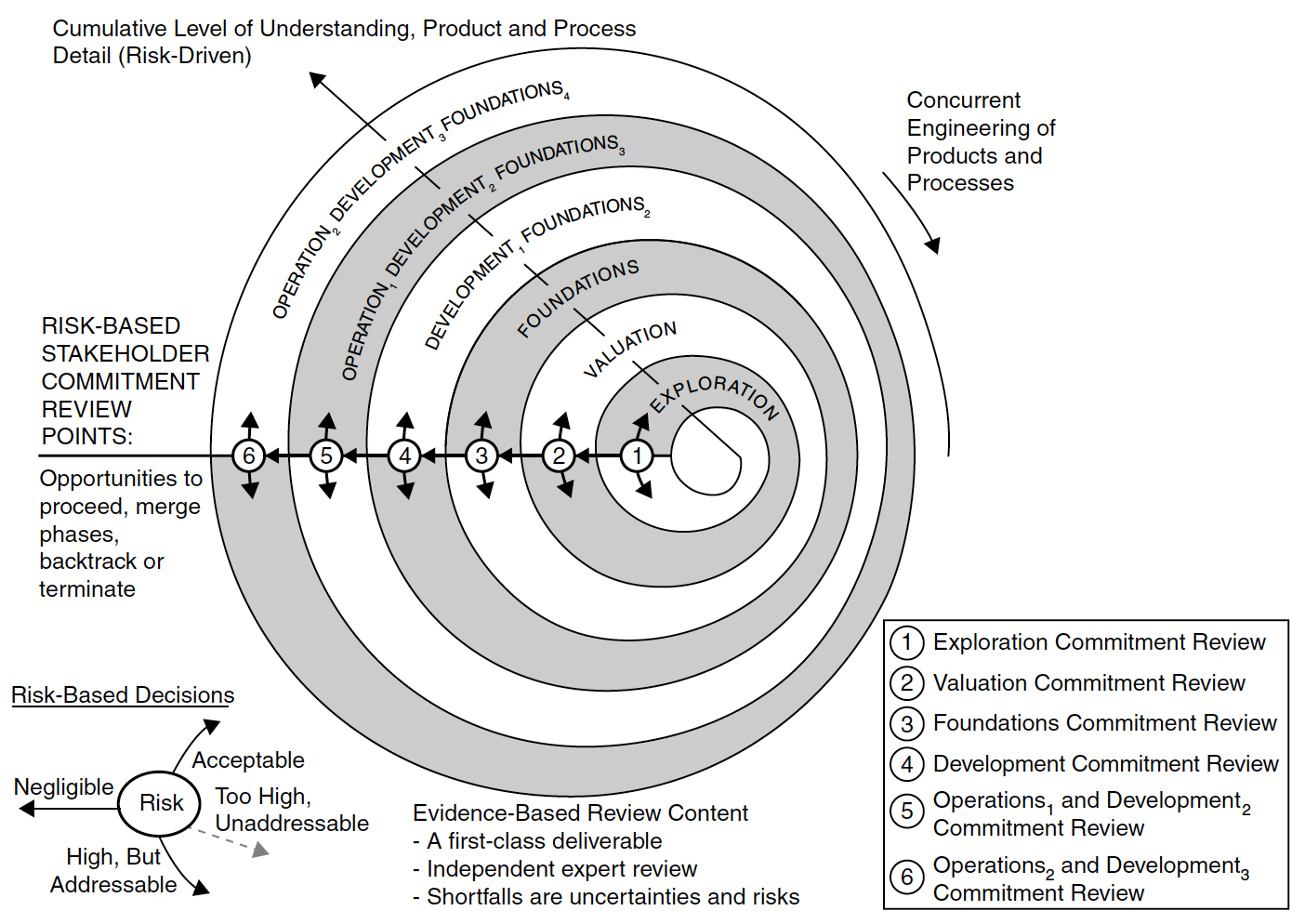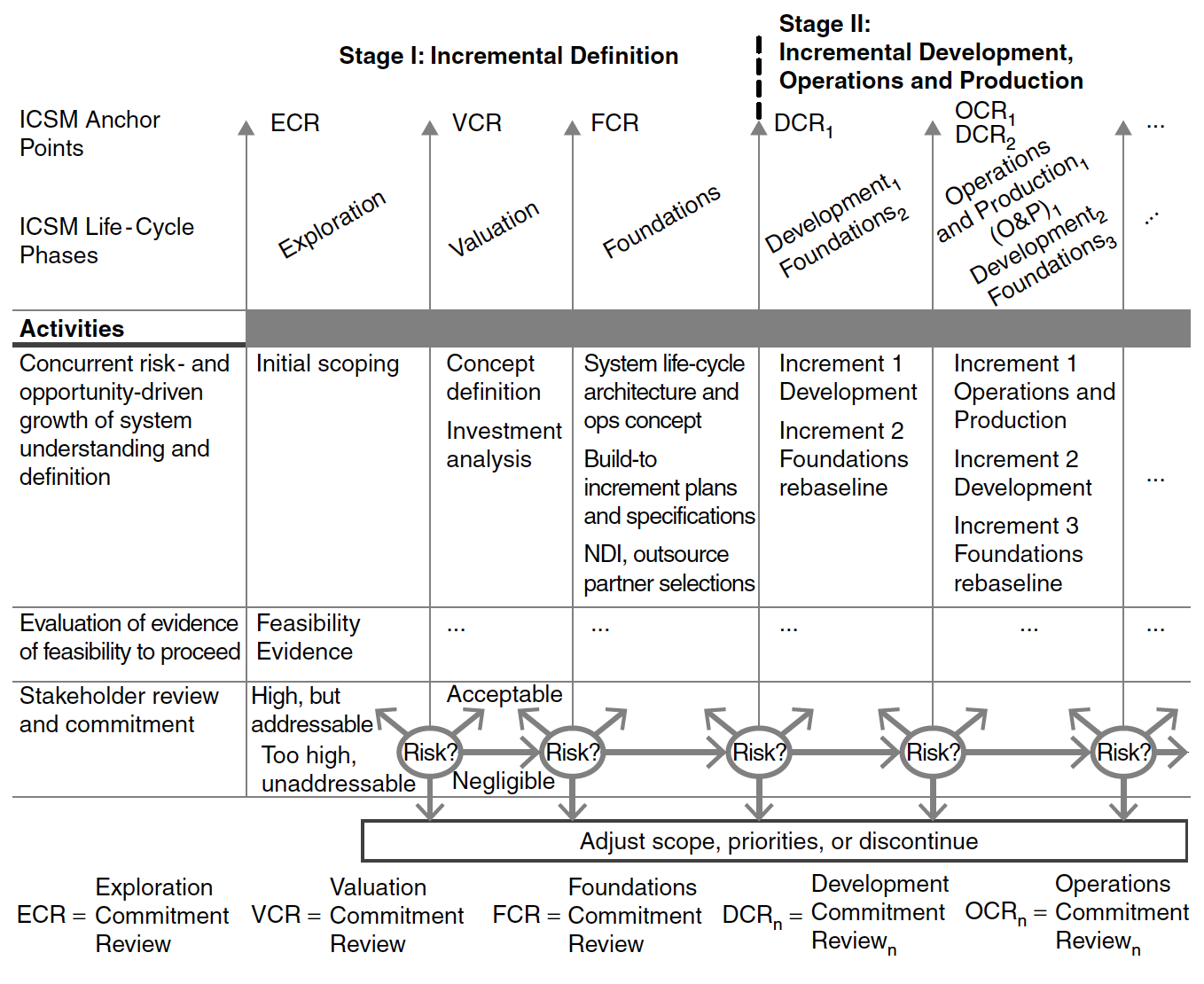The Incremental Commitment Spiral Model (ICSM) is a principles-based, process framework or meta-model that supports the definition of life-cycle processes based on the characteristics, constraints, and risks associated with a given project or program. It incorporates the system success definition and is both technology and stakeholder aware.
The ICSM handles projects of all sizes, but is particularly applicable to projects requiring multiple life-cycle models for various components:
- New or legacy components
- Software, hardware, or cyber-physical systems
- Unprecedented or common components
- Critical or nice-to-have components
Like the original spiral model, the ICSM is incremental and concurrent in nature, has specific approaches for establishing stakeholders’ commitment for those increments before moving forward, and is dependent on evidence- and risk-based decisions.
Given that one-step total corporate makeovers are highly risky, the ICSM does not present itself as an all-or-nothing model. Organizations can and do adopt its key practices incrementally.
Metaphors for Applying the ICSM
To illustrate these principles, here are two different but useful ways of thinking about why risk-driven, concurrent, incremental commitment can bring about successful systems.
Playing the Odds. The first simple metaphor to help understand the ICSM is to compare it to incremental-commitment gambling games such as poker or blackjack, rather than to single-commitment gambling games such as roulette. Many system development projects operate like roulette, in which a full set of requirements is specified upfront, the full set of resources is committed to an essentially fixed-price contract, and one waits to see if the bet was a good one. The ICSM is more like poker or blackjack, in that one places an increasing series of bets to see whether the prospects of a win are good, and decides whether to continue betting based on better information about the prospects of success.
Life Together. Our second metaphor is somewhat more personal. The major ICSM life-cycle phases and milestones work well as common commitment points across a variety of process model variants because they reflect similar commitment points during one’s lifetime. Exploration is the equivalent of investing time in going out on dates (yes, the object of desire looks good and seems reasonably intelligent, but so do some others). The Valuation phase leads to the decision point at which you and a partner decide to go steady, investing some of your degrees of freedom in exploring the prospects of a more serious commitment (we’re interested enough to forgo other dalliances for a while to see if this could really be “it”). The Foundations phase results in the investment in rings, bringing in other stakeholders, and possibly making domicile arrangements (someone says yes to a “Will you marry me?” question, but is not yet an “until death do us part” commitment). The firmer commitment happens at the Development Commitment Review (the equivalent of “officially, legally, and in sight of God and everybody” getting married). As in life, if you marry your system architecture and plans in haste, you and your stakeholders will repent at leisure (if. in Internet time, any leisure time is available). Finally, the Operations Commitment Review constitutes an even larger commitment (having your first child, with all the associated commitments of care and feeding of a legacy system).
As with most metaphors, the correspondence of these decision points is not perfect. Nevertheless, the analogies of failure are pertinent: prematurely committing to infeasible requirements and spending lots of resources to create a failed outcome is similar to out-of-sequence life experiences such as dating, creating a child, getting married, and then finding that you can’t live with each other.
The ICSM Spiral View

The spiral view is helpful in clarifying that the ICSM is not a single one-size-fits-all process model, but rather a process generation model, in which a project’s particular risk patterns and process drivers steer it toward achieving success with respect to its particular objectives, constraints, and priorities. Unlike in the traditional sequential approaches, each spiral concurrently rather than sequentially addresses all of the activities of product development. Every spiral considers:
- Requirements (objectives and constraints)
- Solutions (alternatives)
- Products and processes
- Hardware
- Software
- Human factors aspects
- Business case analysis of alternative product configurations
- Product line investments
- Intentional reflection at all levels
All of this concurrency is synchronized and stabilized by the development team producing not only management and engineering artifacts but also evidence of their combined feasibility. Independent experts assess this evidence at the various stakeholder commitment decision milestones. Any shortfalls in evidence are considered risks, and significant risks should then be addressed by a risk mitigation plan.
The ICSM Phased View

The phased view shows how the overall life-cycle process divides naturally into two major stages. Stage I, Incremental Definition, covers the upfront growth in system understanding, definition, feasibility assurance, and stakeholder commitment. If the Stage I activities do not result in taking an off-ramp, they lead to a larger Stage II commitment to implement a feasible set of specifications and plans for Incremental Development and Operations of the desired system.
A Feasibility Evidence Description is the focus of each of the concurrency stabilization review. It contains evidence provided by the developer and validated by independent experts that, if the system is built to the specified architecture, it will:
- Satisfy the requirements: capability, interface, level of service, and evolution
- Support the operational concept
- Be buildable within the budgets and schedules in the plan
- Generate a viable return on investment
- Generate satisfactory outcomes for all of the success-critical stakeholders
- Resolve all major risks by treating shortfalls in evidence as risks and covering them by risk management plans
- Serve as a basis for stakeholders’ commitment to proceed
Principles Trump Diagrams
The Four ICSM Principles:
- Stakeholder value-based guidance.
- Incremental commitment and accountability.
- Concurrent multi-discipline engineering.
- Evidence and risk-based decisions.
Risk Meta-Principle of Balance: Balancing the risk of doing too little and the risk of doing too much will generally find a middle course sweet spot that is about the best you can do.
Theory W (Win-Win) Success Theorem: A system will succeed if and only if it makes winners of its success-critical stakeholders.
System Success Realization Theorem: Making winners of your success-critical stakeholders requires:
- Identifying all of the success-critical stakeholders.
- Understanding how each stakeholder wants to win.
- Having the success-critical stakeholders negotiate among themselves a win-win set of product and process plans.
- Controlling progress toward the negotiated win-win realization, including adapting it to change.
Reference



